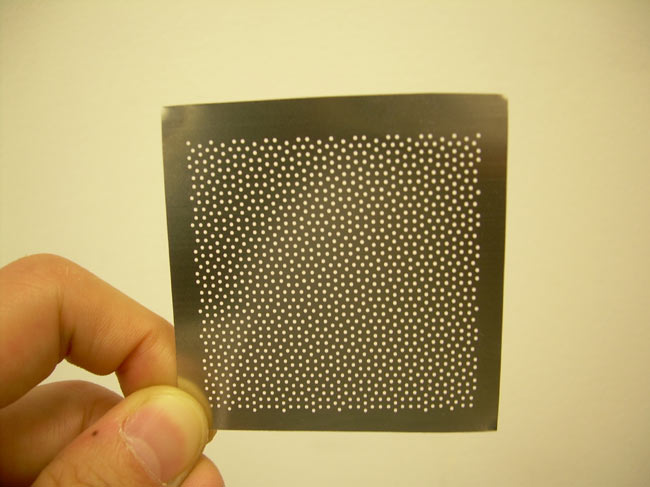Light Seems to Pass through Solid Metal

Researchers directing a special type of light at metal poked with holes in irregular patterns recently discovered that all the light behaved like a liquid and fell across the metal to find its way through the escape holes.
That means the light was acting pretty weird. Picture shining a flashlight at your kitchen colander. While some of the light from the flashlight will travel through its holes, the solid part of the colander will keep much of the light from shining through.
In contrast, experiments described in the March 28 issue of the journal Nature demonstrated that terahertz radiation--a low-frequency light on the electromagnetic spectrum located between microwaves and mid-infrared regions--traveled around a thin sheet of metal, through patterned holes, and all of it came out the other side. Experts sometimes refer to this radiation as T-rays.
"You can get 100 percent transmission of light, even if holes only make up 20 percent of the area," University of Utah physicist Ajay Nahata told LiveScience. Nahata is one of the experimenters.
A 'surprising' earlier finding
Although it sounds simple, understanding how so much light can move around to fit through holes is a relatively new idea. An explanation started when Thomas Ebbesen illustrated in research published in 1998 that the amount of visible light that traveled through a single hole was more than scientists expected.
"It was surprising, because a hole is the simplest thing you could imagine," said electrical engineer Daniel Mittleman, who works in Rice University's T-ray lab but is not affiliated with the new study.
Get the world’s most fascinating discoveries delivered straight to your inbox.
Since Ebbesen's findings, researchers have assumed that the theory only applied to light traveling through holes in periodic patterns, such as squares. But Nahata and physicist Z. Valy Vardeny found in the new experiments that light moved across the metal surface and passed through holes in a number of different irregular designs.
Nahata and Vardeny are also the first researchers to observe how terahertz radiation reacts with the metal and around the holes. While visible light oscillates so quickly that it's difficult to measure, scientists can accurately gauge the low frequency of terahertz radiation.
"By using terahertz, you can really see how and when light comes out of the holes," Mittleman told LiveScience. "Once you illuminate the hole, some light goes through and some comes out a little later."
T-rays and other light
Since all light waves tend to act similarly, Mittleman said, researchers can assume that the behavior they observe of the terahertz radiation also occurs across the electromagnetic spectrum.
The University of Utah researchers have high hopes for applications of terahertz radiation in wireless communication and homeland security operations.
Today, much of the low-frequency electromagnetic spectrum is crowded with communication and broadcasting signals. Terahertz is unchartered, promising territory, Nahata said, to open up more space for transmitting data at high speeds.
Also, since many everyday materials, such as clothing, plastics and wood look transparent under terahertz imaging, the technology could be used to spot concealed bombs and other explosive devices. In addition, materials absorb T-rays at varying frequencies, depending on the type of material. Anthrax, for example, can be detected with terahertz imaging by its frequency fingerprint.
"We're trying to make building block devices so we can go after a broad range of applications," said Nahata.


